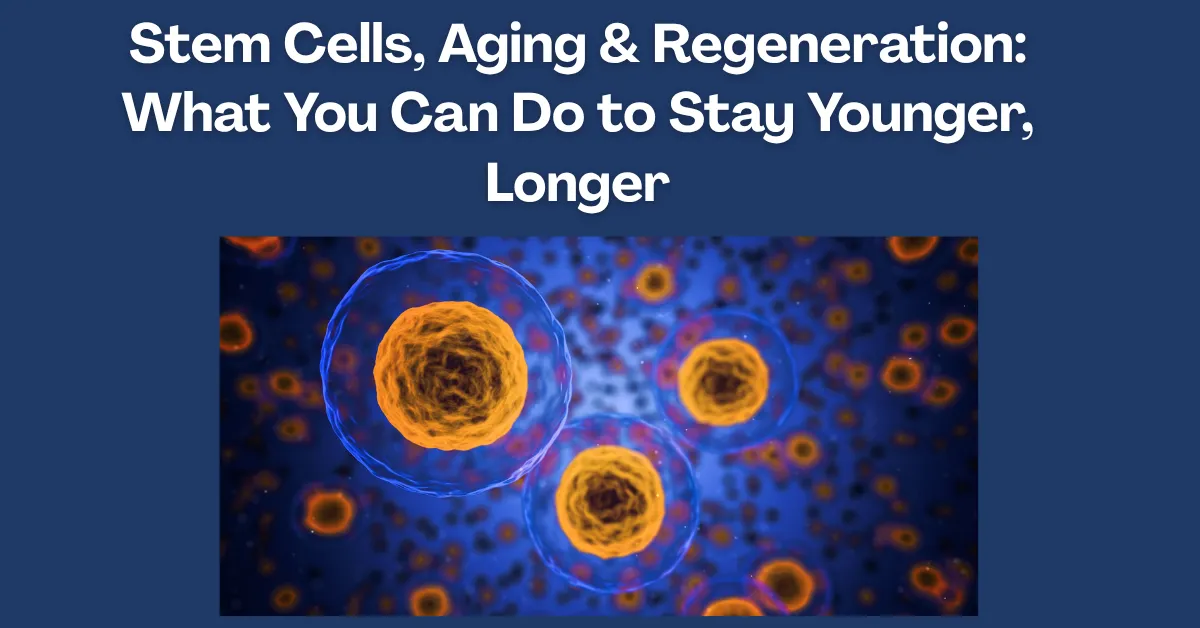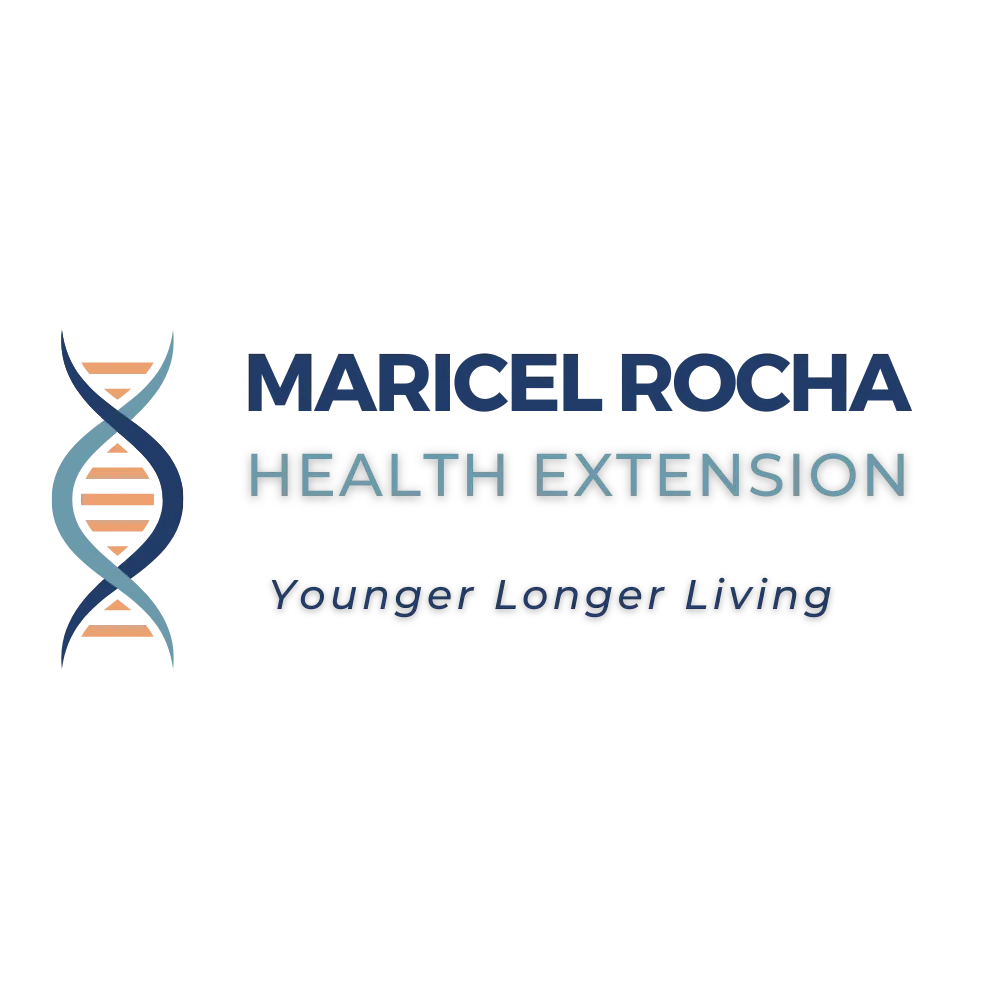
Stem Cells, Aging & Regeneration: What You Can Do to Stay Younger, Longer
Stem Cells, Aging & Regeneration: What You Can Do to Stay Younger, Longer
What if your body’s repair crew slowly started disappearing?
Every time a tissue needed fixing or a cell needed replacing, there were fewer and fewer people on the job—until damage simply stopped being repaired.
This is exactly what happens during stem cell exhaustion, one of the core hallmarks of aging.
The Body’s Repair Crew—Worn Out
Stem cells are your body's built-in system for regeneration and renewal. They help you heal after injury, keep tissues young and strong, and replace cells that naturally wear out.
But as we age, these powerful cells decline in number and function. They don’t replenish as easily, they respond more slowly, and many lose their ability to divide at all.
This process—called stem cell exhaustion—has been linked to slower healing, a weaker immune system, more fragile bones, and the kind of deep fatigue and inflammation that many associate with “just getting older.”
What Drives Stem Cell Exhaustion?
Several factors contribute to stem cell depletion as we age, including:
Chronic inflammation
Oxidative stress
Blood sugar imbalances
Toxin exposure
Lack of deep, restorative sleep
Poor diet and physical inactivity
Over time, these stressors create an internal environment that’s toxic for regeneration.

Start Here: The Fundamentals First
Before we dive into advanced interventions, it's important to be clear:
You cannot regenerate from a place of imbalance.
Biohacking tools are not magic—they’re amplifiers. And without a strong foundation, they won’t help you recover what your body has lost. So first, you need to optimize your biology through the basics.
5 Core Strategies to Protect Stem Cell Health
🛏️ 1. Deep Sleep is Non-Negotiable
A recent 2023 study in Life Sciences found that disruptions in circadian rhythm and sleep quality can impair stem cell proliferation, migration, and differentiation—the very functions we rely on for tissue regeneration and healing.
In other words, poor sleep accelerates aging at the cellular level. Prioritizing deep, consistent rest is one of the most powerful tools you have to preserve your body’s natural repair systems.
🥗 2. Nourish with Real Food
Studies show that people who follow a Mediterranean-style diet—rich in plants, polyphenols, and healthy fats—have longer telomeres, lower inflammation, and better cellular function. This supports a healthier stem cell niche and reduces the risk of chronic disease.
🏃 3. Move Your Body
Regular exercise signals your body to activate and release stem cells. Resistance training in older adults has been shown to increase muscle stem cell numbers, while aerobic activity supports stem cell function in the brain, heart, and bones.
🕰️ 4. Use Fasting to Stimulate Regeneration
Short-term fasting has been shown to promote autophagy (the clean-up of damaged cells) and stem cell activation. Research led by Dr. Valter Longo showed that fasting triggers immune system regeneration through stem cell pathways.
🧘 5. Manage Stress
Chronic emotional or physical stress increases cortisol and inflammatory cytokines, both of which are known to inhibit stem cell regeneration. Meditation, breathing practices, nature exposure, and emotional processing help restore that balance.
Now, Once the Basics Are Covered… Add “Luxury Strategies”
Once your body is no longer inflamed, exhausted, or overwhelmed, you can unlock the full benefits of advanced interventions. Here are three research-backed tools that may help promote stem cell function and healthy aging:

1. Red/NIR Light Therapy (Photobiomodulation)
Low-level red and near-infrared light helps support mitochondrial energy production and may enhance stem cell activation—especially in tissues like skin and muscle. Clinical studies support its role in wound healing and tissue repair.
2. Hyperbaric Oxygen Therapy (HBOT)
HBOT has been shown to increase circulating stem cells and lengthen telomeres in healthy aging adults. It creates an oxygen-rich environment that helps repair and regenerate tissue. While not essential for everyone, it can be a valuable option when recovery is the goal.
3. Targeted Prebiotic Fiber to Feed Butyrate Producers
Our gut is home to trillions of bacteria, and many of them play a key role in reducing inflammation and supporting stem cell health—if you feed them right.
When you consume specific types of prebiotic fibers, they fuel beneficial bacteria (like Faecalibacterium prausnitzii and Roseburia spp.), which then produce butyrate—a powerful short-chain fatty acid (postbiotic) that helps regulate immune response, supports the intestinal barrier, and protects the local stem cell niche from stress and dysfunction.
A healthy butyrate supply has been shown to reduce systemic inflammation and support tissue repair.
Key Butyrate-Producing Fibers and Their Food Sources:
1. Inulin and Fructooligosaccharides (FOS)
Found in: Garlic, onions, leeks, asparagus, Jerusalem artichokes, chicory root, and bananas (especially slightly green)
2. Resistant Starch
Found in: Cooked and cooled potatoes, green bananas, lentils, oats, cooked and cooled rice, and legumes like chickpeas
3. Pectin
Found in: Apples (especially with skin), citrus fruits, carrots, plums, and pears
4. Beta-glucans
Found in: Oats, barley, reishi mushrooms, and seaweed (such as kombu)
Final Thought: Regeneration is a Lifestyle, Not a Hack
Stem cell exhaustion is not something that happens suddenly—it's a reflection of how well you've supported your body over time.
You don’t need shortcuts. You need strategy.
Start with what’s essential: your sleep, food, movement, mindset, and recovery.
Then, build from there.
Your body's repair crew is ready to get back to work—if you give them the right environment.
Want More on the Hallmarks of Aging?
Visit my blog at www.healthspan.maricelrocha.com
Explore more on how your biology ages—and what you can do every day to slow it down.
References
Longo, V. D., et al. (2014).
Fasting-mimicking diet and stem cell-based regeneration.
Cell Stem Cell, 14(6), 810–823.
https://doi.org/10.1016/j.stem.2014.04.014Zhou, J., Tan, S., & Chen, Y. (2023).
The role of circadian rhythm in regulating stem cells in aging and regenerative medicine.
Life Sciences, 320, 121499.
https://pubmed.ncbi.nlm.nih.gov/30393021Crous-Bou, M., Fung, T. T., Prescott, J., Julin, B., Du, M., Sun, Q., ... & De Vivo, I. (2014).
Mediterranean diet and telomere length in Nurses’ Health Study: population based cohort study.
BMJ, 349, g6674.
https://doi.org/10.1136/bmj.g6674Englund, D. A., Kirking, J. R., Armstrong, C. L., Grothe, D. R., Zollinger, D. R., Bastron, R. T., ... & McDermott, M. M. (2021).
Exercise reduces circulating biomarkers of cellular senescence in humans.
Aging Cell, 20(4), e13415.
https://doi.org/10.1111/acel.13415Kaiko, G. E., Ryu, S. H., Koues, O. I., Collins, P. L., Solnica-Krezel, L., Pearce, E. J., ... & Stappenbeck, T. S. (2016).
The colonic crypt protects stem cells from microbiota-derived metabolites.
Cell, 165(7), 1708–1720.
https://doi.org/10.1016/j.cell.2016.05.018Moradi, S., Nouri, M., Moradi, MT. et al. The mutual impacts of stem cells and sleep: opportunities for improved stem cell therapy. Stem Cell Res Ther 16, 157 (2025). https://doi.org/10.1186/s13287-025-04235-3

